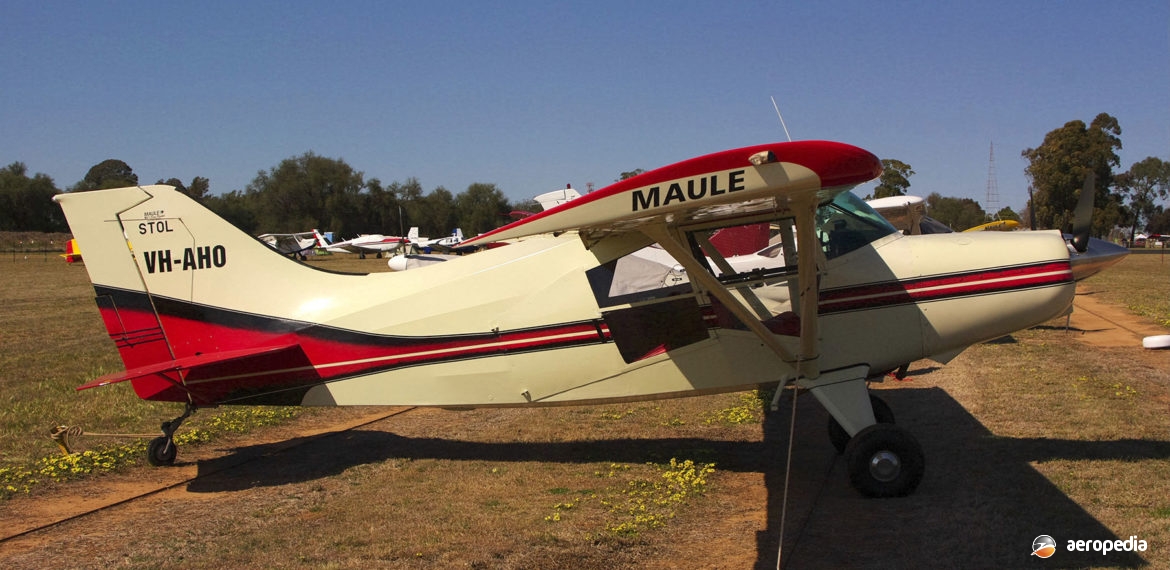Photograph:
Maule MX-7-180 Super Rocket VH-AHO (c/n 11059C) at Narromine, NSW in September 2012 (David C Eyre)
Country of origin:
United States of America
Description:
Light general purpose utility aircraft
Power Plant:
One 175 kw (235 hp) Textron Lycoming O-540-B4B5 six cylinder horizontally-opposed air-cooled engine
Specifications:
- Wingspan: 10.04 m (32 ft 11 in)
- Length: 7.16 m (23 ft 6 in)
- Height: 1.95 m (6 ft 4 in)
- Wing area: 15.38 m² (165.6 sq ft)
- Max speed at sea level: 273 km/h (170 mph)
- Max cruising speed at 75% power: 257 km/h (160 mph)
- Stalling speed, flaps down, power off: 57 km/h (35 mph)
- Max rate of climb: 610 m/min (2,000 ft/min)
- Service ceiling: 6,096 m (20,000 ft)
- Fuel capacity: 276 litres (61 Imp gals)
- Take-off run: 182 m (597 ft)
- Landing run: 152 m (499 ft)
- Range with standard fuel: 788 km (490 miles)
- Range with auxiliary fuel: 1,384 km (860 miles)
- Empty weight: 669 kg (1,475 lb)
- Max baggage: 113 kg (250 lb)
- Loaded weight: 1,134 kg (2,500 lb)
- Load factors: +3.8 / -1.5G
History:
The next series in the Maule range was the M-7, which commenced with the M-7-235 Super Rocket five seater with a 175 kw (235 hp) Avco Lycoming IO-540-W engine. The MX-7 Star Rocket had the short span wing of the M-5, increased fuel capacity, ailerons and flaps of the M-7, the fuselage of the M-6, powered by either the 134 kw (180 hp) Avco Lycoming O-360-C1F or the 175 kw (235 hp) Avco Lycoming O-540-W1A5D or IO-540-W engine. The M-6 was only produced in small numbers, but had an extended wing and greater fuel capacity. The M-7 replaced the M-6 on the production line in 1984. The M-7 series is also available with a tricycle undercarriage.
Maule Aircraft went into liquidation in 1975 and was replaced by a new company, Maule Air Inc, which has continued production of the M-5 , M-7 and M-9 series. Examples appear on the Australian and New Zealand registers. In 1999 Maule fitted a PZL (Poland) built Franklin 150 kw (205 hp) 6A-350-C1R engine to an MX-7 Rocket, and later a Teledyne Continental TSIO-360. The Maule series has been popular with seaplane operators, a number in Australia being fitted with floats and used for pilot training and charter work, particularly tourist flights over Sydney, the south coast of NSW, and around the Port Arthur region of Tasmania.
The range of models available has become quite diverse and includes the MX-7-160 Sportplane, a four-seater with a 119 kw (160 hp) Textron Lycoming O-320-B2D engine; MXT-7-160 Comet variant with a tricycle landing gear and seating two but with four seats optional; MX-7-180-A Sportplane with the 134 kw (180 hp) Textron Lycoming O-360-C4F engine; MXT7-180A Comet variant of the Sportplane with a tricycle undercarriage and four seats as standard; MX7-180B Star Rocket with a 134 kw (180 hp) Textron Lycoming O-360-C1F engine and five-position flaps; MX-7-180C similar to the latter with a spring aluminium main undercarriage; and MXT-7-180 Star Rocket with a tricycle undercarriage.
The M-7-235B Super Rocket seats five and can be fitted with either the O-540-A5 or O-540-B4B5 engine. The M-7-235C Orion is similar to the latter with an aluminium spring undercarriage; M-7-235 Super Rocket similar to the latter with a tricycle undercarriage, four-position flaps and an IO-540-W1A5 engine; M-7-260 with the IO-540-V4A5 engine; M-7-260C with a 194 kw (260 hp) Textron Lycoming IO-540-V4A5 engine; MT-7-260 with a 194 kw (260 hp) IO-540-V4A5 engine; and M7-420AC which is basically the fuselage of the M-7 with longer wings, fitted with a 313 kw (420 hp) Allison 250-B17C turboprop engine, a spring aluminium tailwheel undercarriage, this model having a rate of climb of 1,097 m/min (3,600 ft/min).
The Maule series has been described as a sturdy, go-anywhere taildragger with an amazing STOL performance that crops up on airports and bush strips all around the world, being easily recognisable as a Maule. Despite the problems with product liability laws in the United States, Maule, a small family company, kept building aeroplanes. As noted above, a variety of models has been available, with a short wing of 9.4 metre (29 ft 8 in) span, a long wing of 10 metres (32 ft 9 in), an extra long wing of 10.9 metres (35 ft 7 in), with power plants ranging from 119 kw (160 hp) up to the fuel injected 194 kw (260 hp) model, and the turbine powered model.
A late model in the series was the M-9-230, first flown in July 2003 fitted with a turbo-charged 172 kw (230 hp) French-built SMA SR305 engine which used Jet A fuel. This model has four fuel tanks with a capacity of 322 litres (71 Imp gals), a max take-off weight of 1,270 kw (2,800 lb) and a range of almost 1,609 km (1,000 miles).
On 22 November 2013 a new variant known as the M-7-235C Orion was registered in Australia to Trojan Air Tech, becoming VH-IJH (c/n 25015C – ex N616PL, N616EL).

